Jianjun Wu
NetGPT: A Native-AI Network Architecture Beyond Provisioning Personalized Generative Services
Jul 23, 2023



Abstract:Large language models (LLMs) have triggered tremendous success to empower daily life by generative information, and the personalization of LLMs could further contribute to their applications due to better alignment with human intents. Towards personalized generative services, a collaborative cloud-edge methodology sounds promising, as it facilitates the effective orchestration of heterogeneous distributed communication and computing resources. In this article, after discussing the pros and cons of several candidate cloud-edge collaboration techniques, we put forward NetGPT to capably deploy appropriate LLMs at the edge and the cloud in accordance with their computing capacity. In addition, edge LLMs could efficiently leverage location-based information for personalized prompt completion, thus benefiting the interaction with cloud LLMs. After deploying representative open-source LLMs (e.g., GPT-2-base and LLaMA model) at the edge and the cloud, we present the feasibility of NetGPT on the basis of low-rank adaptation-based light-weight fine-tuning. Subsequently, we highlight substantial essential changes required for a native artificial intelligence (AI) network architecture towards NetGPT, with special emphasis on deeper integration of communications and computing resources and careful calibration of logical AI workflow. Furthermore, we demonstrate several by-product benefits of NetGPT, given edge LLM's astonishing capability to predict trends and infer intents, which possibly leads to a unified solution for intelligent network management \& orchestration. In a nutshell, we argue that NetGPT is a promising native-AI network architecture beyond provisioning personalized generative services.
RHFedMTL: Resource-Aware Hierarchical Federated Multi-Task Learning
Jun 01, 2023Abstract:The rapid development of artificial intelligence (AI) over massive applications including Internet-of-things on cellular network raises the concern of technical challenges such as privacy, heterogeneity and resource efficiency. Federated learning is an effective way to enable AI over massive distributed nodes with security. However, conventional works mostly focus on learning a single global model for a unique task across the network, and are generally less competent to handle multi-task learning (MTL) scenarios with stragglers at the expense of acceptable computation and communication cost. Meanwhile, it is challenging to ensure the privacy while maintain a coupled multi-task learning across multiple base stations (BSs) and terminals. In this paper, inspired by the natural cloud-BS-terminal hierarchy of cellular works, we provide a viable resource-aware hierarchical federated MTL (RHFedMTL) solution to meet the heterogeneity of tasks, by solving different tasks within the BSs and aggregating the multi-task result in the cloud without compromising the privacy. Specifically, a primal-dual method has been leveraged to effectively transform the coupled MTL into some local optimization sub-problems within BSs. Furthermore, compared with existing methods to reduce resource cost by simply changing the aggregation frequency, we dive into the intricate relationship between resource consumption and learning accuracy, and develop a resource-aware learning strategy for local terminals and BSs to meet the resource budget. Extensive simulation results demonstrate the effectiveness and superiority of RHFedMTL in terms of improving the learning accuracy and boosting the convergence rate.
Semantics-enhanced Temporal Graph Networks for Content Caching and Energy Saving
Feb 02, 2023



Abstract:The enormous amount of network equipment and users implies a tremendous growth of Internet traffic for multimedia services. To mitigate the traffic pressure, architectures with in-network storage are proposed to cache popular content at nodes in close proximity to users to shorten the backhaul links. Meanwhile, the reduction of transmission distance also contributes to the energy saving. However, due to limited storage, only a fraction of the content can be cached, while caching the most popular content is cost-effective. Correspondingly, it becomes essential to devise an effective popularity prediction method. In this regard, existing efforts adopt dynamic graph neural network (DGNN) models, but it remains challenging to tackle sparse datasets. In this paper, we first propose a reformative temporal graph network, which is named STGN, that utilizes extra semantic messages to enhance the temporal and structural learning of a DGNN model, since the consideration of semantics can help establish implicit paths within the sparse interaction graph and hence improve the prediction performance. Furthermore, we propose a user-specific attention mechanism to fine-grainedly aggregate various semantics. Finally, extensive simulations verify the superiority of our STGN models and demonstrate their high potential in energy-saving.
AoI-based Temporal Attention Graph Neural Network for Popularity Prediction and Content Caching
Aug 18, 2022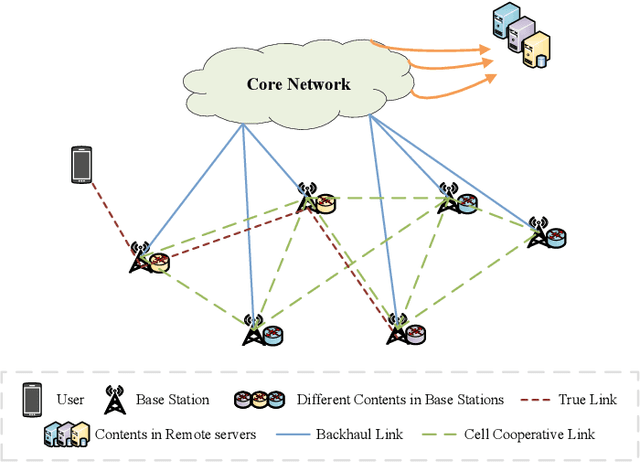
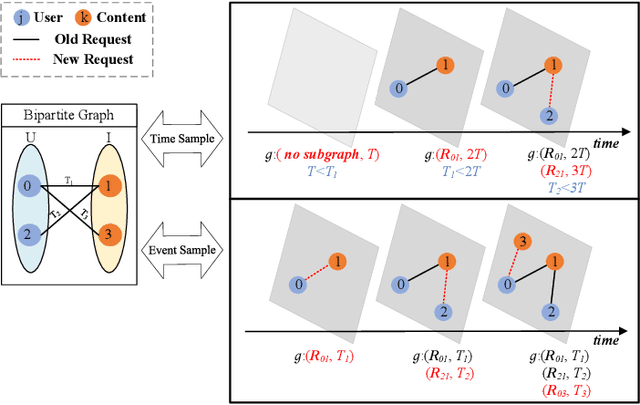
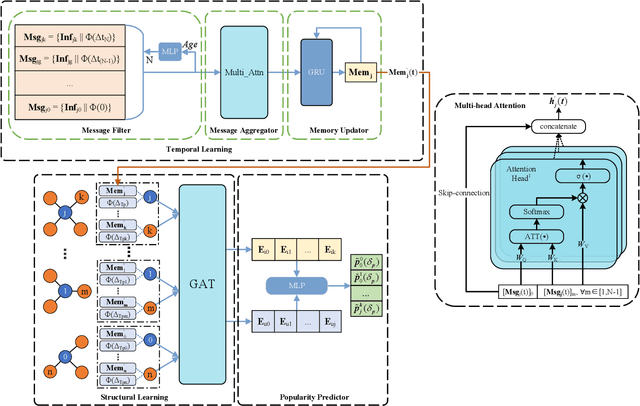
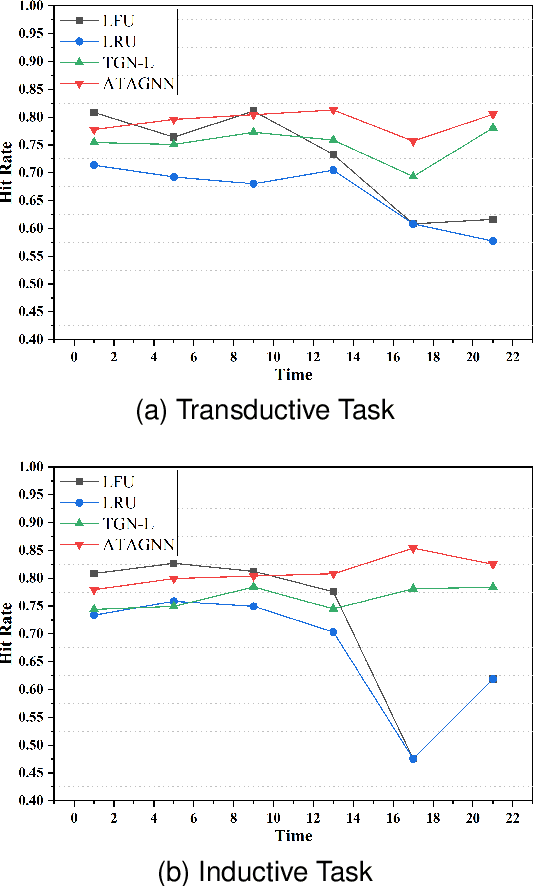
Abstract:Along with the fast development of network technology and the rapid growth of network equipment, the data throughput is sharply increasing. To handle the problem of backhaul bottleneck in cellular network and satisfy people's requirements about latency, the network architecture like information-centric network (ICN) intends to proactively keep limited popular content at the edge of network based on predicted results. Meanwhile, the interactions between the content (e.g., deep neural network models, Wikipedia-alike knowledge base) and users could be regarded as a dynamic bipartite graph. In this paper, to maximize the cache hit rate, we leverage an effective dynamic graph neural network (DGNN) to jointly learn the structural and temporal patterns embedded in the bipartite graph. Furthermore, in order to have deeper insights into the dynamics within the evolving graph, we propose an age of information (AoI) based attention mechanism to extract valuable historical information while avoiding the problem of message staleness. Combining this aforementioned prediction model, we also develop a cache selection algorithm to make caching decisions in accordance with the prediction results. Extensive results demonstrate that our model can obtain a higher prediction accuracy than other state-of-the-art schemes in two real-world datasets. The results of hit rate further verify the superiority of the caching policy based on our proposed model over other traditional ways.
Rethinking Modern Communication from Semantic Coding to Semantic Communication
Oct 16, 2021
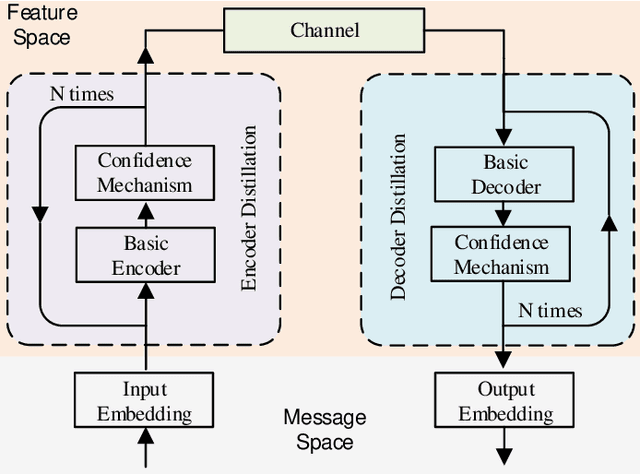

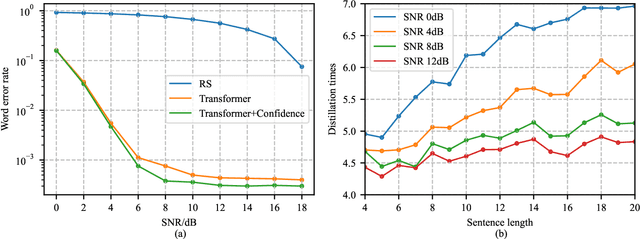
Abstract:Modern communications are usually designed to pursue a higher bit-level precision and fewer bits required to transmit a message. This article rethinks these two major features and introduces the concept and advantage of semantics that characterizes a new kind of semantics-aware communication mechanism, incorporating both the semantic encoding and the semantic communication problem. Within the unified framework, we analyze the underlying defects of existing semantics-aware techniques and establish a confidence-based distillation mechanism for the joint semantics-noise coding (JSNC) problem, and a reinforcement learning (RL)-powered semantic communication paradigm that endows a system the ability to convey the semantics instead of pursuing the bit level accuracy. On top of these technical contributions, this work provides a new insight to understand how the semantics are processed and represented in a semantics-aware coding and communication system, and verifies the significant benefits of doing so.
Learning Deep Representations by Mutual Information for Person Re-identification
Aug 16, 2019



Abstract:Most existing person re-identification (ReID) methods have good feature representations to distinguish pedestrians with deep convolutional neural network (CNN) and metric learning methods. However, these works concentrate on the similarity between encoder output and ground-truth, ignoring the correlation between input and encoder output, which affects the performance of identifying different pedestrians. To address this limitation, We design a Deep InfoMax (DIM) network to maximize the mutual information (MI) between the input image and encoder output, which doesn't need any auxiliary labels. To evaluate the effectiveness of the DIM network, we propose end-to-end Global-DIM and Local-DIM models. Additionally, the DIM network provides a new solution for cross-dataset unsupervised ReID issue as it needs no extra labels. The experiments prove the superiority of MI theory on the ReID issue, which achieves the state-of-the-art results.
 Add to Chrome
Add to Chrome Add to Firefox
Add to Firefox Add to Edge
Add to Edge